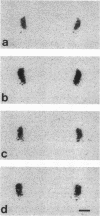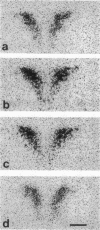Abstract
Electroconvulsive shock (ECS) is a highly effective therapy for the treatment of major depression, but its mechanisms of action are not known. We report that repeated ECS in rats produces enduring changes in two clinically relevant stress-responsive brain systems: (a) the hypothalamic-pituitary-adrenal axis regulated by corticotropin-releasing hormone (CRH) in the paraventricular nucleus; and (b) the NE system in the locus coeruleus regulated by tyrosine hydroxylase (TH). CRH and TH mRNA levels in these brain regions were assessed by in situ hybridization histochemistry. A single interaural ECS elevated TH but not CRH mRNA measured 24 h later. Repeated daily treatments (3, 7, or 14) elevated both mRNAs, maximally with 7, correlating with the time course of clinical efficacy. The elevations persisted for 3 (CRH) or 8 wk (TH) after the ECS. No other therapeutic treatment is known to produce such long-lasting changes in central nervous system gene expression. The time course of events (delayed onset, long duration) implicate CRH as a principal mediator of the antidepressant effects of ECS. The locus coeruleus-NE system may be important in initiating the central nervous system response.
Full text
PDF





Images in this article
Selected References
These references are in PubMed. This may not be the complete list of references from this article.
- Arriza J. L., Simerly R. B., Swanson L. W., Evans R. M. The neuronal mineralocorticoid receptor as a mediator of glucocorticoid response. Neuron. 1988 Nov;1(9):887–900. doi: 10.1016/0896-6273(88)90136-5. [DOI] [PubMed] [Google Scholar]
- Biguet N. F., Buda M., Lamouroux A., Samolyk D., Mallet J. Time course of the changes of TH mRNA in rat brain and adrenal medulla after a single injection of reserpine. EMBO J. 1986 Feb;5(2):287–291. doi: 10.1002/j.1460-2075.1986.tb04211.x. [DOI] [PMC free article] [PubMed] [Google Scholar]
- Brady L. S., Gold P. W., Herkenham M., Lynn A. B., Whitfield H. J., Jr The antidepressants fluoxetine, idazoxan and phenelzine alter corticotropin-releasing hormone and tyrosine hydroxylase mRNA levels in rat brain: therapeutic implications. Brain Res. 1992 Feb 14;572(1-2):117–125. doi: 10.1016/0006-8993(92)90459-m. [DOI] [PubMed] [Google Scholar]
- Brady L. S., Whitfield H. J., Jr, Fox R. J., Gold P. W., Herkenham M. Long-term antidepressant administration alters corticotropin-releasing hormone, tyrosine hydroxylase, and mineralocorticoid receptor gene expression in rat brain. Therapeutic implications. J Clin Invest. 1991 Mar;87(3):831–837. doi: 10.1172/JCI115086. [DOI] [PMC free article] [PubMed] [Google Scholar]
- Bunney W. E., Jr, Post R. M., Andersen A. E., Kopanda R. T. A neuronal receptor sensitivity mechanism in affective illness (a review of evidence). Commun Psychopharmacol. 1977;1(4):393–405. [PubMed] [Google Scholar]
- Chrousos G. P., Gold P. W. The concepts of stress and stress system disorders. Overview of physical and behavioral homeostasis. JAMA. 1992 Mar 4;267(9):1244–1252. [PubMed] [Google Scholar]
- Deakin J. F., Ferrier I. N., Crow T. J., Johnstone E. C., Lawler P. Effects of ECT on pituitary hormone release: relationship to seizure, clinical variables and outcome. Br J Psychiatry. 1983 Dec;143:618–624. doi: 10.1192/bjp.143.6.618. [DOI] [PubMed] [Google Scholar]
- Delitala G., Masala A., Rosati G., Aiello I., Agnetti V. Effect of electroconvulsive therapy (electroshock) on plasma ACTH, GH, LH, FSH, TSH and 11-OH-CS in patients with mental disorders. Panminerva Med. 1977 Jul-Aug;19(4):237–243. [PubMed] [Google Scholar]
- Drouin J., Chamberland M., Charron J., Jeannotte L., Nemer M. Structure of the rat pro-opiomelanocortin (POMC) gene. FEBS Lett. 1985 Nov 25;193(1):54–58. doi: 10.1016/0014-5793(85)80078-8. [DOI] [PubMed] [Google Scholar]
- Enns M. Electrical dosage and efficacy in electroconvulsive therapy. Can J Psychiatry. 1991 Jun;36(5):344–348. doi: 10.1177/070674379103600505. [DOI] [PubMed] [Google Scholar]
- Fink M., Ottosson J. O. A theory of convulsive therapy in endogenous depression: significance of hypothalamic functions. Psychiatry Res. 1980 Mar;2(1):49–61. doi: 10.1016/0165-1781(80)90006-2. [DOI] [PubMed] [Google Scholar]
- Gleiter C. H., Nutt D. J. Chronic electroconvulsive shock and neurotransmitter receptors--an update. Life Sci. 1989;44(15):985–1006. doi: 10.1016/0024-3205(89)90550-x. [DOI] [PubMed] [Google Scholar]
- Glue P., Costello M. J., Pert A., Mele A., Nutt D. J. Regional neurotransmitter responses after acute and chronic electroconvulsive shock. Psychopharmacology (Berl) 1990;100(1):60–65. doi: 10.1007/BF02245791. [DOI] [PubMed] [Google Scholar]
- Gold P. W., Chrousos G., Kellner C., Post R., Roy A., Augerinos P., Schulte H., Oldfield E., Loriaux D. L. Psychiatric implications of basic and clinical studies with corticotropin-releasing factor. Am J Psychiatry. 1984 May;141(5):619–627. doi: 10.1176/ajp.141.5.619. [DOI] [PubMed] [Google Scholar]
- Gold P. W., Goodwin F. K., Chrousos G. P. Clinical and biochemical manifestations of depression. Relation to the neurobiology of stress (1) N Engl J Med. 1988 Aug 11;319(6):348–353. doi: 10.1056/NEJM198808113190606. [DOI] [PubMed] [Google Scholar]
- Gold P. W., Loriaux D. L., Roy A., Kling M. A., Calabrese J. R., Kellner C. H., Nieman L. K., Post R. M., Pickar D., Gallucci W. Responses to corticotropin-releasing hormone in the hypercortisolism of depression and Cushing's disease. Pathophysiologic and diagnostic implications. N Engl J Med. 1986 May 22;314(21):1329–1335. doi: 10.1056/NEJM198605223142101. [DOI] [PubMed] [Google Scholar]
- Grahame-Smith D. G., Green A. R., Costain D. W. Mechanism of the antidepressant action of electroconvulsive therapy. Lancet. 1978 Feb 4;1(8058):254–257. doi: 10.1016/s0140-6736(78)90495-6. [DOI] [PubMed] [Google Scholar]
- Grima B., Lamouroux A., Blanot F., Biguet N. F., Mallet J. Complete coding sequence of rat tyrosine hydroxylase mRNA. Proc Natl Acad Sci U S A. 1985 Jan;82(2):617–621. doi: 10.1073/pnas.82.2.617. [DOI] [PMC free article] [PubMed] [Google Scholar]
- Herman J. P., Cullinan W. E., Young E. A., Akil H., Watson S. J. Selective forebrain fiber tract lesions implicate ventral hippocampal structures in tonic regulation of paraventricular nucleus corticotropin-releasing hormone (CRH) and arginine vasopressin (AVP) mRNA expression. Brain Res. 1992 Oct 2;592(1-2):228–238. doi: 10.1016/0006-8993(92)91680-d. [DOI] [PubMed] [Google Scholar]
- Herman J. P., Schäfer K. H., Sladek C. D., Day R., Young E. A., Akil H., Watson S. J. Chronic electroconvulsive shock treatment elicits up-regulation of CRF and AVP mRNA in select populations of neuroendocrine neurons. Brain Res. 1989 Nov 6;501(2):235–246. doi: 10.1016/0006-8993(89)90641-0. [DOI] [PubMed] [Google Scholar]
- Jingami H., Mizuno N., Takahashi H., Shibahara S., Furutani Y., Imura H., Numa S. Cloning and sequence analysis of cDNA for rat corticotropin-releasing factor precursor. FEBS Lett. 1985 Oct 21;191(1):63–66. doi: 10.1016/0014-5793(85)80994-7. [DOI] [PubMed] [Google Scholar]
- Kendell R. E. The present status of electroconvulsive therapy. Br J Psychiatry. 1981 Oct;139:265–283. doi: 10.1192/bjp.139.4.265. [DOI] [PubMed] [Google Scholar]
- Kling M. A., Roy A., Doran A. R., Calabrese J. R., Rubinow D. R., Whitfield H. J., Jr, May C., Post R. M., Chrousos G. P., Gold P. W. Cerebrospinal fluid immunoreactive corticotropin-releasing hormone and adrenocorticotropin secretion in Cushing's disease and major depression: potential clinical implications. J Clin Endocrinol Metab. 1991 Feb;72(2):260–271. doi: 10.1210/jcem-72-2-260. [DOI] [PubMed] [Google Scholar]
- Lerer B. Electroconvulsive shock and neurotransmitter receptors: implications for mechanism of action and adverse effects of electroconvulsive therapy. Biol Psychiatry. 1984 Mar;19(3):361–383. [PubMed] [Google Scholar]
- Masserano J. M., Takimoto G. S., Weiner N. Electroconvulsive shock increases tyrosine hydroxylase activity in the brain and adrenal gland of the rat. Science. 1981 Nov 6;214(4521):662–665. doi: 10.1126/science.6117127. [DOI] [PubMed] [Google Scholar]
- Miesfeld R., Rusconi S., Godowski P. J., Maler B. A., Okret S., Wikström A. C., Gustafsson J. A., Yamamoto K. R. Genetic complementation of a glucocorticoid receptor deficiency by expression of cloned receptor cDNA. Cell. 1986 Aug 1;46(3):389–399. doi: 10.1016/0092-8674(86)90659-8. [DOI] [PubMed] [Google Scholar]
- Monroe R. R., Jr Maintenance electroconvulsive therapy. Psychiatr Clin North Am. 1991 Dec;14(4):947–960. [PubMed] [Google Scholar]
- Nemeroff C. B., Bissette G., Akil H., Fink M. Neuropeptide concentrations in the cerebrospinal fluid of depressed patients treated with electroconvulsive therapy. Corticotrophin-releasing factor, beta-endorphin and somatostatin. Br J Psychiatry. 1991 Jan;158:59–63. doi: 10.1192/bjp.158.1.59. [DOI] [PubMed] [Google Scholar]
- Nemeroff C. B., Widerlöv E., Bissette G., Walléus H., Karlsson I., Eklund K., Kilts C. D., Loosen P. T., Vale W. Elevated concentrations of CSF corticotropin-releasing factor-like immunoreactivity in depressed patients. Science. 1984 Dec 14;226(4680):1342–1344. doi: 10.1126/science.6334362. [DOI] [PubMed] [Google Scholar]
- Pearlman C. Electroconvulsive therapy. Current concepts. Gen Hosp Psychiatry. 1991 Mar;13(2):128–137. doi: 10.1016/0163-8343(91)90024-q. [DOI] [PubMed] [Google Scholar]
- Reid W. H. Electroconvulsive therapy. Tex Med. 1993 May;89(5):58–62. [PubMed] [Google Scholar]
- Roy A., Pickar D., Paul S., Doran A., Chrousos G. P., Gold P. W. CSF corticotropin-releasing hormone in depressed patients and normal control subjects. Am J Psychiatry. 1987 May;144(5):641–645. doi: 10.1176/ajp.144.5.641. [DOI] [PubMed] [Google Scholar]
- Rudorfer M. V., Risby E. D., Osman O. T., Gold P. W., Potter W. Z. Hypothalamic--pituitary--adrenal axis and monoamine transmitter activity in depression: a pilot study of central and peripheral effects of electroconvulsive therapy. Biol Psychiatry. 1991 Feb 1;29(3):253–264. doi: 10.1016/0006-3223(91)91287-2. [DOI] [PubMed] [Google Scholar]
- Sackeim H. A., Prudic J., Devanand D. P., Kiersky J. E., Fitzsimons L., Moody B. J., McElhiney M. C., Coleman E. A., Settembrino J. M. Effects of stimulus intensity and electrode placement on the efficacy and cognitive effects of electroconvulsive therapy. N Engl J Med. 1993 Mar 25;328(12):839–846. doi: 10.1056/NEJM199303253281204. [DOI] [PubMed] [Google Scholar]
- Smith M. A., Brady L. S., Glowa J., Gold P. W., Herkenham M. Effects of stress and adrenalectomy on tyrosine hydroxylase mRNA levels in the locus ceruleus by in situ hybridization. Brain Res. 1991 Mar 22;544(1):26–32. doi: 10.1016/0006-8993(91)90881-u. [DOI] [PubMed] [Google Scholar]
- Thiagarajan A. B., Gleiter C. H., Mefford I. N., Eskay R. L., Nutt D. J. Effect of single and repeated electroconvulsive shock on the hypothalamic-pituitary-adrenal axis and plasma catecholamines in rats. Psychopharmacology (Berl) 1989;97(4):548–552. doi: 10.1007/BF00439562. [DOI] [PubMed] [Google Scholar]
- Weiner N., Hossain M. A., Masserano J. M. The effects of electroconvulsive shock on catecholamine function in the locus ceruleus and hippocampus. J Neural Transm Suppl. 1991;34:3–9. doi: 10.1007/978-3-7091-9175-0_1. [DOI] [PubMed] [Google Scholar]
- Weizman A., Gil-Ad I., Grupper D., Tyano S., Laron Z. The effect of acute and repeated electroconvulsive treatment on plasma beta-endorphin, growth hormone, prolactin and cortisol secretion in depressed patients. Psychopharmacology (Berl) 1987;93(1):122–126. doi: 10.1007/BF02439598. [DOI] [PubMed] [Google Scholar]




